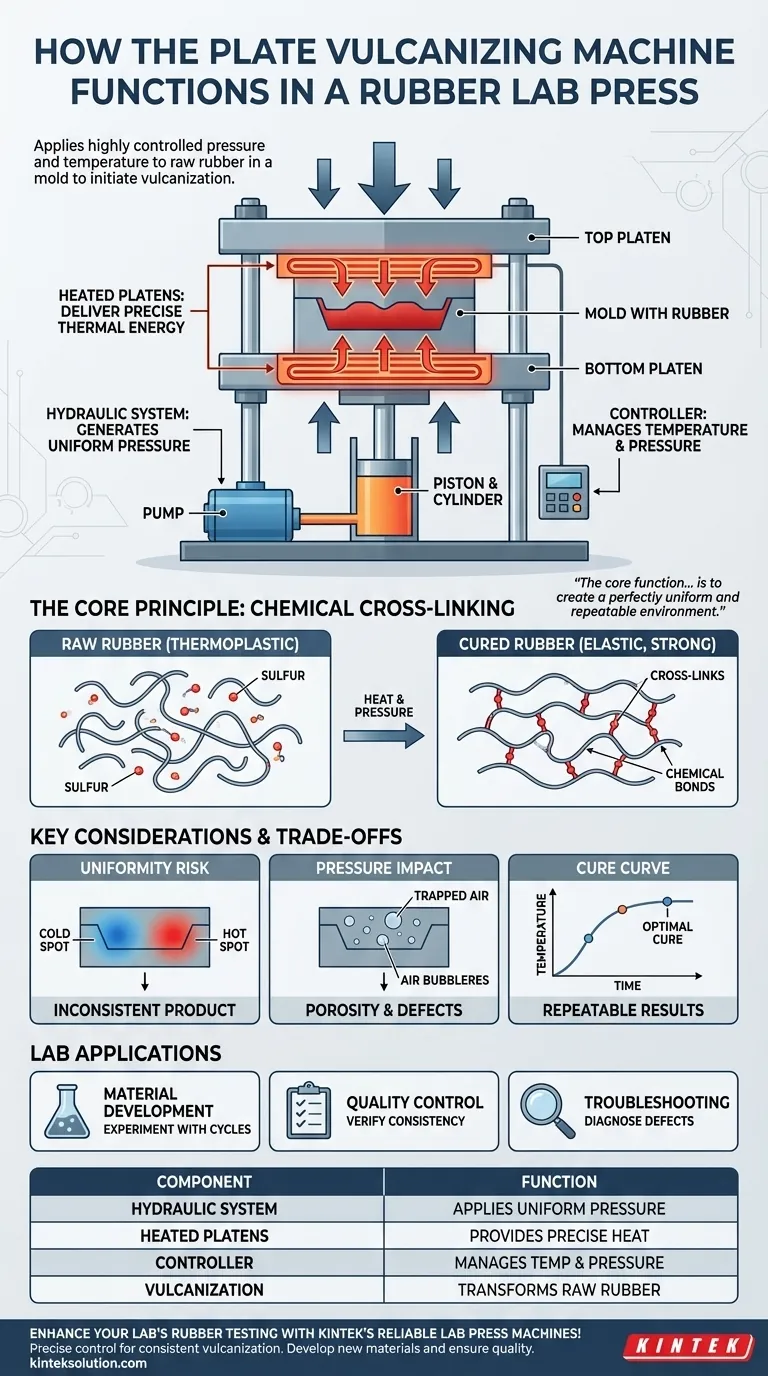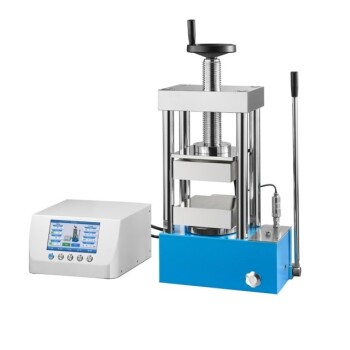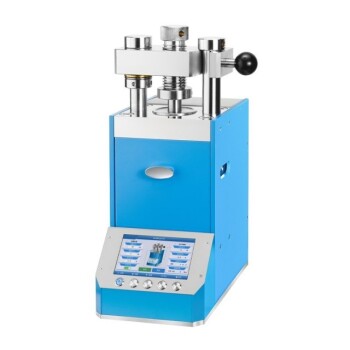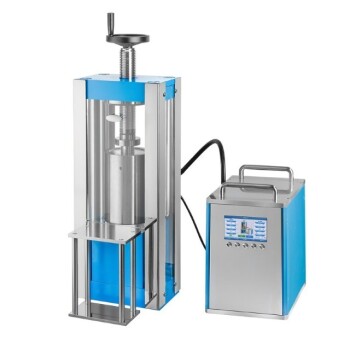In essence, a plate vulcanizing machine functions by applying highly controlled pressure and temperature to a raw rubber compound held within a mold. The machine's hydraulic system generates immense, uniform pressure, while its heated plates (platens) provide precise, stable heat. This combination of forces initiates a chemical reaction called vulcanization, transforming the soft, pliable rubber into a strong, durable, and elastic material.
The core function of a laboratory vulcanizing press is not merely to heat and squeeze rubber. It is to create a perfectly uniform and repeatable environment, ensuring that the critical chemical cross-linking process happens identically every single time you run a test.
The Core Principle: A Controlled Chemical Transformation
Before a rubber compound is vulcanized, it is a thermoplastic material—it's soft, sticky, and has very little structural integrity or elasticity. The purpose of the vulcanizing press is to permanently change this on a molecular level.
The Goal: Chemical Cross-linking
Vulcanization uses energy (heat) to create chemical bonds, or "cross-links," between the long polymer chains that make up the rubber. These cross-links act like the rungs of a ladder, tying the chains together.
This new molecular structure prevents the polymer chains from moving independently, which is what gives the final product its characteristic strength, elasticity, and resistance to heat and solvents.
The Catalysts: Heat and Pressure
While sulfur and other additives in the rubber compound are the chemical agents for this reaction, heat is the catalyst that makes it happen at a practical speed.
Pressure serves two critical functions:
- It ensures the rubber flows and completely fills every detail of the mold.
- It maintains intimate contact between the rubber and the hot plate surfaces, guaranteeing efficient and uniform heat transfer.
Deconstructing the Machine's Function
A plate vulcanizing press is a system of two primary components working in unison: a pressure system and a heating system, both governed by a central controller.
The Pressure System: The Hydraulic Press
The immense force required for vulcanization is generated by a hydraulic system. A pump pressurizes a fluid (typically hydraulic oil), which then acts on a large piston inside a hydraulic cylinder.
This piston is connected to the bottom platen of the press. As the fluid pressure increases, it pushes the piston and the platen upward, closing the press and clamping the mold with thousands of pounds of force. The key is to deliver this pressure evenly across the entire surface of the mold.
The Heating System: The Heated Platens
The top and bottom plates of the press, known as platens, are responsible for delivering thermal energy. These are thick, heavy steel plates designed to hold and distribute heat evenly.
Heating is most often accomplished with electric resistance heating elements embedded within the platens. In some industrial applications, channels for circulating steam or hot oil may be used. A temperature controller (PID controller) constantly monitors the platen temperature and adjusts the power to the heaters to maintain a precise and stable setpoint.
Understanding the Trade-offs and Key Considerations
The precision of a laboratory press is paramount because any deviation can ruin the test sample and lead to incorrect conclusions about the material's properties.
The Risk of Uneven Curing
If the platens have "hot spots" or "cold spots," different parts of the rubber sample will cure at different rates. This results in an inconsistent product where some areas might be under-cured and weak, while others are over-cured and brittle.
The Impact of Pressure and Flow
Applying pressure too quickly or unevenly can trap air in the mold, leading to porosity and defects in the final sample. It can also cause improper material flow, preventing the mold from filling completely. The pressure must be controlled throughout the entire curing cycle.
The Criticality of the "Cure Curve"
The relationship between time, temperature, and the material's properties is known as its cure curve. The primary job of a lab press is to follow a pre-determined cure recipe with absolute fidelity to produce a valid test specimen.
Applying This Knowledge in the Lab
Understanding these principles allows you to use the vulcanizing press not just as a tool, but as a diagnostic instrument.
- If your primary focus is material development: Your goal is to use the press's precise controls to experiment with different cure cycles and find the optimal time, temperature, and pressure for a new rubber compound.
- If your primary focus is quality control: You will use the press to run standardized tests, verifying that production batches of rubber cure consistently and meet predefined physical property specifications.
- If your primary focus is troubleshooting defects: An understanding of how uneven pressure or temperature affects the final product is your key to diagnosing issues like surface blemishes, porosity, or inconsistent hardness in cured parts.
By mastering the function of the vulcanizing press, you gain fundamental control over the final properties of any rubber product you are working with.
Summary Table:
| Component | Function |
|---|---|
| Hydraulic System | Applies uniform pressure to mold and rubber compound |
| Heated Platens | Provides precise, stable heat for chemical cross-linking |
| Controller | Manages temperature and pressure for repeatable results |
| Vulcanization Process | Transforms soft rubber into durable, elastic material |
Enhance your laboratory's rubber testing with KINTEK's reliable lab press machines! Specializing in automatic lab presses, isostatic presses, and heated lab presses, we deliver precise pressure and temperature control for consistent vulcanization. Whether you're developing new materials or ensuring quality control, our equipment helps you achieve accurate, repeatable results. Contact us today to discuss how our solutions can optimize your lab's efficiency and support your rubber research needs!
Visual Guide

Related Products
- Laboratory Hydraulic Press 2T Lab Pellet Press for KBR FTIR
- Manual Heated Hydraulic Lab Press with Integrated Hot Plates Hydraulic Press Machine
- Laboratory Hydraulic Press Lab Pellet Press Button Battery Press
- Laboratory Split Manual Heated Hydraulic Press Machine with Hot Plates
- Automatic Heated Hydraulic Press Machine with Heated Plates for Laboratory
People Also Ask
- How do hydraulic press machines ensure precision and consistency in pressure application? Achieve Reliable Force Control for Your Lab
- How are hydraulic presses used in spectroscopy and compositional determination? Enhance Accuracy in FTIR and XRF Analysis
- What are the benefits of reduced physical effort and space requirements in hydraulic mini presses? Boost Lab Efficiency and Flexibility
- What are some laboratory applications of hydraulic presses? Boost Precision in Sample Prep and Testing
- What are the advantages of using the hydraulic portable press for making KBr pellets? Achieve Superior FT-IR Sample Prep



















